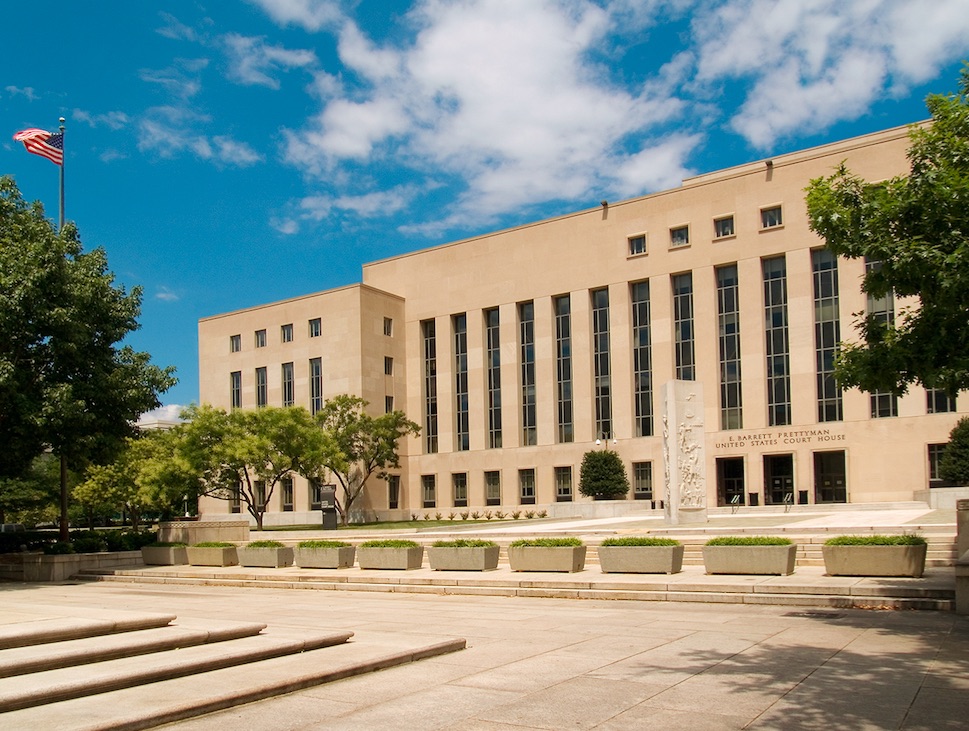Published by The Lawfare Institute
in Cooperation With

The president and his allies have a new line of attack against the Carter Page FISA application: the FISA Court did not hold a hearing to adjudicate the merits of the application. As one of the early peddlers of this line of argument put it on Twitter:
When FBI wanted to wiretap Carter Page, and used dossier as evidence, did FISA judge ask tough, probing questions on surveillance application? No. No hearing at all. From @JudicialWatch: https://t.co/bQvKmLFbfu pic.twitter.com/1pQL2npto0
— Byron York (@ByronYork) August 31, 2018
As I explained on Twitter, the people making this argument—including the president—are drawing a false equivalency between a FISA judge asking “tough, probing questions,” and holding a “hearing.” I made this argument chiefly by linking to and quoting from a publicly-available letter, sent by the FISA Court to Congress in 2013, describing how the FISA process actually works. The two central points I tried to make in my tweets were, first, that FISA applications get serious scrutiny, with the FISA Court itself reporting “substantive changes” made “as a result of Court inquiry or action” in 24.4 percent of cases over a three-month period; and, second, that the FISA Court typically conducts that scrutiny through informal telephone calls and meetings with the government rather than through formal hearings. So the absence of a hearing is not cause for alarm or a conclusion that the court glossed over a FISA application.
In case there is pent-up demand for even more detailed insight into FISA, this post offers a longer description of the process. It’s also a teaser for the forthcoming third edition of “National Security Investigations and Prosecutions,” the treatise that I co-wrote with Doug Wilson. The third edition has been undergoing prepublication review by the government in one form or another since February 2018, so you can’t see it yet. What follows, however, is derived from previously-cleared material (including the second edition of the treatise, other cleared blog posts of mine, and the FISA Court’s own public statements), so I think it is safe to present.
FISA establishes the Foreign Intelligence Surveillance Court (also known as the FISC), which consists of 11 district judges chosen publicly by the Chief Justice of the United States and drawn from at least seven of the federal judicial circuits. (For more detail on the selection process, see this CRS report; for a list of all judges who have served on the FISC, see here). Judges on the FISC sit for staggered seven-year terms and ordinarily continue to serve as judges in their home districts. A judge may not sit for more than one seven-year term on the FISC. The “presiding judge” of the FISC functions more or less like a chief judge of a district court, with powers and duties set forth in the FISC’s publicly-available rules.
The FISC sits in a secure courtroom in the federal courthouse in Washington, D.C. (prior to 2009, it sat in a secure courtroom inside the Department of Justice Building). In general, each of the 11 judges sits for all or part of one week every 11 weeks, maintaining a continuous rotation. The FISC has a clerk of court, and he or she maintains a docket of more or less the usual sort as prescribed by the court’s rules. The record of proceedings before the FISC, including the docket, applications, and orders, is by statute “maintained under security measures established by the Chief Justice in consultation with the Attorney General and the Director of National Intelligence.” These security measures have been made public as Exhibit B to this document.
The FISC’s rules provide that—apart from emergencies—“proposed applications and orders must be submitted no later than seven days before the government seeks to have the matter entertained by the Court,” and that the “final application,” with the Attorney General’s approval and other required elements, may be submitted “no later than 10:00 a.m. Eastern Time on the day the government seeks to have the matter entertained by the Court.” Changes made between the proposed application and the final application must be specifically identified to the FISC. Applications raising “an issue not previously before the Court – including, but not limited to, novel issues of technology or law” – must also be identified. With the FISC’s approval, applications and signatures may be submitted electronically.
Applications under FISA are heard by a single FISC judge, and by statute and rule the government may not ask a second judge to consider an application for electronic surveillance or a physical search after one FISC judge has denied it. Instead, if a judge denies such an application, the government’s only statutory remedy is to take an appeal to the Foreign Intelligence Surveillance Court of Review.
In practice, however, the FISA process has not always worked in such a rigid and formal way. For example, in 2002, Judge Royce Lamberth explained how the submission and decision process functioned during his tenure as presiding judge of the FISC:
I bristle at the suggestion in some quarters that we are rubber stamps for the government, because no applications have been formally denied in recent years. Some have been revised, some have been withdrawn and resubmitted with additional information, and the process is working. It is working, in part, because the [A]ttorney [G]eneral is conscientiously doing his job, and his staff is, as well.
James Baker, then the Counsel for Intelligence Policy in charge of the Justice Department office that presented applications to the FISA Court, echoed these sentiments in an interview conducted for Frontline, the PBS television series:
I just want to say that the idea that the FISA court is a rubber stamp is to my mind ridiculous, and I think the American people need to know that.
I think folks really don’t understand the process. They don’t understand the give-and-take . . . . [W]e have an interactive process with the FISA court. So if they have questions – they don’t understand something about the application, they have a concern about the application some way, they don’t think the facts are sufficient on a particular point or a particular element of the statute – they’ll ask us about it, and they’ll say, “Well, do you have any more information on this one point?” We’ll say: “We don’t know, Judge. We’ll go back and find out. We’ll go back to an FBI field office, let’s say, and ask them. They’ll say, “Well, actually we do have some additional information.” So we’ll file a supplemental document, submit that to the court, and then the court might be satisfied, and then the matter is resolved; the application is approved.
So could the court, when it first got the application, just have received it, have the question, decided it was insufficient, denied it or issued some kind of order? I guess they could have in that kind of a scenario, but that’s not how the process works. The process is more interactive than that.
In 2013, Presiding Judge Reggie Walton of the FISA Court sent a letter to Sen. Patrick Leahy describing the court’s operations in detail. This is the letter that I cited in my tweets, and it is currently available on the Court’s website. The letter explains that in most cases, “a proposed application,” also known as a “read copy” of the application, “must be submitted by the government no later than seven days before the government seeks to have the matter entertained” by the court. Once the read copy arrives, “a member of the Court’s legal staff reviews the application,” and “will often have one or more telephone conversations with” the government’s lawyers in the National Security Division (NSD) at the Justice Department, “to seek additional information and/or raise concerns about the application.” The letter elaborates on this process (emphasis added):
Under FISA practice, the first set of interactions often take place at the staff level. The Court’s legal staff frequently interacts with the government in various ways in the context of examining the legal sufficiency of applications before they are presented in final form to a judge. Indeed, in the process of reviewing the government’s applications and submissions in order to provide advice to the judge, the legal staff interact with the government on a daily basis. These daily interactions typically consist of secure telephone conversations in which legal staff ask the government questions about the legal and factual elements of applications or submissions. These questions may originate with legal staff after an initial review of an application or submission, or they may come from a judge.
At the direction of the Presiding Judge or the judge assigned to a matter, Court legal staff sometimes meet with the government in connection with applications and submissions. The Court typically requests such meetings when a proposed application or submission presents a special legal or factual concern about which the Court would like additional information (e.g., a novel use of technology or a request to use a new surveillance or search technique). The frequency of such meetings varies depending on the Court’s assessment of its need for additional information in matters before it and the most conducive means to obtain that information. Court legal staff may meet with the government as often as 2-3 times a week, or as few as 1-2 times a month, in connection with the various matters pending before the Court.
The letter also describes some of the types of additional information sought from the government before an application is submitted in final form (emphasis added):
Additional facts to justify the government’s belief that its application meets the legal requirements for the type of authority it is seeking (e.g., in the case of electronic surveillance, that might include additional information to justify the government’s belief that a target of surveillance is a foreign power or an agent of a foreign power . . . or that the target is using or about to use a particular facility . . .; additional facts about how the government intends to implement statutorily required minimization procedures . . .; additional information about the government’s prior implementation of a Court order, particularly if the government has previously failed to comply fully with a Court order; or additional information about novel issues of technology or law.
In an interview, Judge Walton said that work on the FISA Court is “very demanding. Information that is submitted by the government is 50, 60, 70 pages or more. And obviously you have to read more information to familiarize yourself with what the government is requesting.”
Based in part on these interactions, the FISC’s staff attorney at some point “prepares a written analysis of the application for the duty judge, which includes an identification of any weaknesses, flaws, or other concerns” with the application. The “judge then reviews the proposed application, as well as the attorney’s written analysis” and “typically makes a preliminary determination” about how he or she wants to proceed, which the court’s attorney then communicates back to the government. As I explained in my tweets, possibilities include that a preliminary determination that the judge “is prepared to approve the application . . . an inclination to impose conditions . . . determining that additional information is needed . . . or determining that a hearing would be appropriate before deciding whether to grant the application.” If the government doesn’t agree with the judge’s preliminary determination, it can “request a hearing, even if the judge did not otherwise intend to require one . . . for example, to challenge conditions that the judge has indicated he or she would impose on the approval of an application.”
With respect to hearings, in particular, the court’s letter explains that their “frequency . . . varies depending on the nature and complexity” of a case and “the individual preferences of different judges.” But it is important to understand, as described above, that the court gets “additional information . . .from the government . . . through telephone conversations [and] meetings” that occur on an ongoing and regular basis, as well as through more formal “hearings.” Indeed, as the court explained in its letter, “typically” the interaction is conducted via “informal communications.” In other words, formal hearings are not typical, and the absence of a hearing does not suggest the absence of scrutiny by the court.
Finally, Judge Walton’s letter also addresses statistical information about the FISA Court’s approval rates. It explains (italics in original) that “the annual statistics provided to Congress by the Attorney General . . . frequently cited to in press reports as a suggestion that the Court’s approval rate is over 99% . . . reflect only the number of final applications submitted to and acted on by the Court. These statistics do not reflect the fact that many applications are altered prior to final submission or even withheld from final submission entirely, often after an indication that a judge would not approve them.” Excluding “minor technical or typographical changes,” Judge Walton’s letter reports, in “a typical week, the Court seeks additional information or modifies the terms proposed by the government in a significant percentage of cases,” which he later reported was 24.4 percent. Judge Walton also observed that “the approval rate for Title III wiretap applications,” which apply in ordinary criminal cases, is actually “higher than the approval rate for FISA applications . . . as recent statistics show that from 2008 to 2012, only five of 13,593 Title III wiretap applications were requested but not authorized.”
Beginning in 2015, by statute, the FISA Court itself (through the Administrative Office of the U.S. Courts) released certain statistical information, showing similar rates of approval and modification. For example, the report released in 2016 for calendar year 2015 (a partial year of reporting because the relevant reporting law was enacted in June) showed substantive modifications or denials in 174 out of 1,010 applications, and the report released in 2017 for calendar year 2016 showed substantive modifications or denials in 374 applications with 1,378 applications granted without modification. Most recently, in calendar year 2017, as I explained here, the report shows that the court denied 26 FISA applications in full and 50 in part, and modified the orders sought by the government in 391 applications, granting 1,147 applications without modifications.
In sum, the court’s letter and various public statements, as well as the statistical evidence, show that FISA applications are subjected to exacting scrutiny; the FISA Court is not a rubber stamp. And they show that this scrutiny is effectuated in many ways, most of them informal—e.g., regular or ad-hoc telephone calls and meetings between the Court and the government—rather than more formal hearings. The absence of a “hearing” on the Carter Page FISAs does not in any way suggest that the FISA Court treated the applications casually or carelessly.



.jpeg?sfvrsn=f6228483_10)
_-_flickr_-_the_central_intelligence_agency_(2).jpeg?sfvrsn=c1fa09a8_7)

